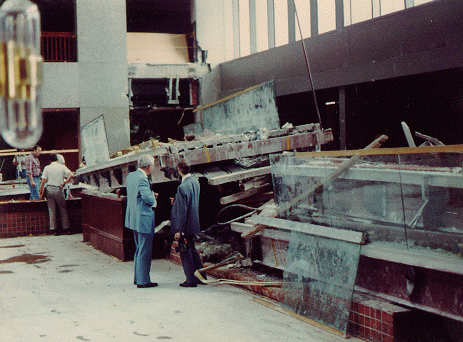Hyatt Regency Hotel in Kansas City
After only two years of construction, the Hyatt Regency Hotel opened in 1980 as part of the Crown Center complex. With an impressive height of 153.62 m (504 ft) and 40 stories, it secured its status as the tallest building in the state of Missouri from 1980 to 1986. It is still the third tallest building in Kansas City. But it was not just its sheer size that made it stand out from the start.
There is a revolving unit on the hotel structure that was used as a restaurant when the building opened – the perfect place for an uninterrupted view of the entire city. But it is not only at the top of the hotel that there are exciting things to discover. As soon as you step over the threshold, the lobby of the Hyatt Regency Hotel impresses you with its multi-story atrium. Three suspended skywalks with a length of 37 m (121.4 ft) seem to float above the heads of the guests.
What happened at the Hyatt Regency Hotel in Kansas City on July 17, 1981?
On July 17, 1981, hundreds of hotel guests and dance enthusiasts from out of town gathered at the Hyatt Regency Hotel. The Tea Dance had become a tradition since the hotel opened a year earlier. In the style of the '50s and '60s, couples danced together in the spacious lobby while enjoying live music and a buffet.
But this time, the popular dance event was about to take a terrible turn. Two of the three skywalks collapsed one after the other, burying hundreds of guests under the rubble. With 114 dead and more than 200 injured, this disaster at the Hyatt Regency Hotel is the largest unintentional collapse disaster in the USA, and second only to 9/11 in U.S. history. But how did this happen?
Background on Hyatt Regency Hotel Disaster in Kansas City, 1981
We have learned from other construction disasters in this blog that the causes of such terrible events are often found in the circumstances of the time. It was the same here. The collapse of the skywalks at the Hyatt Regency Hotel in 1981 was a consequence of the construction policies of the late 1970s.
We already mentioned the oil embargo in our article about the Schwabylon in Munich. In the early 1970s, the Arab countries decided to ban the export of goods to foreign countries. One of these essential resources was oil. As a result, the price of oil rose rapidly throughout the world. Together with the high national debt of the United States during the Vietnam War, the United States slipped further and further into a deep economic crisis.
This was a time of high unemployment and rising interest rates for construction companies. The pressure on the latter continued to increase. Construction projects had to be completed as quickly and as cheaply as possible. Quality was often not the first priority.
In these uncertain times, the goal of the owners was to get their buildings up and running as quickly as possible. Long construction periods were too uneconomical. With this in mind, a fast-track construction method was developed for the construction of large buildings.
The first problems with such buildings began in the late 1970s. The roof of the Hartford Civic Center collapsed in 1978, and the roof of the Kemper Arena gave way in 1979 due to inadequate structural stability. For example, it took just over two years to build the Hyatt Regency Hotel, and again, problems arose during construction: 250 m² (2,691 ft²) of the roof collapsed.
Timing of Hyatt Regency Hotel Collapse on July 17, 1981
To understand the magnitude of this disaster, let's take a closer look at what happened that evening. The tea dance was in full swing and the dancers were enjoying themselves. Several hundred other guests had gathered on the skywalks to watch the event from above.
Collapse of Skywalks at Hyatt Regency Hotel
That Friday evening at 7:05 p.m., an unusual sound stood out from the raucous background noise: a metallic clang. Several times and very loud. People on the second skywalk suddenly ran for the safety of the hotel corridors, but most of them had barely taken a few steps before the floor beneath them gave way.
Then, the whole skywalk collapsed. Directly onto the skywalk below, which connected the second floor of the buildings. Those few seconds alone cost several lives, but it didn't stop there.
The second skywalk now bore the weight of the first and could only hold on for a few moments before it collapsed, too. Before most of the guests of the tea dance in the atrium could react, hundreds of people had been buried under the rubble of the two skywalks.
Rescue and Recovery Works at Hyatt Regency Hotel in 1981
Although all available rescue teams were immediately notified and quickly arrived at the hotel, the rescue and care of those trapped inside was extremely difficult. Volunteers and guests who had survived the collapse also offered their help.
The chaos, the panic of the people, and the mountains of debris meant that it took hours to recover the injured and the dead. Many of those who survived the immediate collapse died during this time from internal bleeding or suffocation in hollow spaces, or they were killed by moving debris.
The Hyatt Regency Hotel and surrounding facilities responded immediately. Temporary wards were quickly set up to care for the injured. Doctors on the scene had to make the most difficult decisions in their profession: who should live and who should die.
In addition to many minor injuries, such as fractures, cuts, bruises, and abrasions, there were an increasing number of serious injuries, such as head injuries, internal bleeding, spinal cord injuries and, ultimately, paraplegia.
Some emergency operations, often on the spot, saved lives. For example, a doctor used a chainsaw to remove an injured man's trapped leg so he could be pulled out of the rubble and treated. Ultimately, 114 people were killed in the accident. More than 250 guests survived their injuries, some with serious, permanent disabilities.
Accident at Hyatt Regency Hotel: Search for Causes
The search for the cause turned out to be a complex process. Many experts worked together to find the reason for the collapse of the skywalks. Initial investigations began while the victims were still being rescued. The remains of the connecting skywalks were collected for later analysis, and the construction drawings were examined in detail.
The materials and fragments of the skywalks were thoroughly examined by several structural engineering experts. This included load testing and modeling, including calculations of the structural integrity of the structure. The experts quickly found the first alarming causes that would forever change the way the construction industry looked at things.
Causes of Collapse of Two Skywalks at Hyatt Regency Hotel in 1981
The initial causes of the collapse of the skywalks were quickly identified. The most important findings of the expert reports are summarized here to give you an initial overview.
1. Construction Error
The main cause of the collapse of the skywalks at the Hyatt Regency Hotel was a serious construction error. The lower skywalk was attached directly to the upper skywalk instead of having its own suspension point, as originally designed.
As a result, the upper skywalk carried the load of the lower skywalk in addition to its own load, even though it was designed to carry only its own load. This was due to a subsequent design change. In short, the failure of the suspension was pre-programmed.
Due to the enormous load at this point on the evening of July 17, 1981, the suspension failed under the unusual crowd of people on both skywalks, one on top of the other. Even with the original structural calculations, the structure would not have been able to withstand this load.
The possibility of such a crowd on the skywalks had simply not been considered in the design. The suspension would have failed under just one-third of the load that evening: a truly alarming result. But it didn't stop there.
2. Changes and Lack of Construction Supervision
It was not only the original structural calculations that were deficient. There were also appalling deficiencies in the construction and acceptance by the construction supervisors and inspectors. This was because the problematic construction practices that led to the failure of the structure were not recognized. The changes to the original design and the decision to attach both overlapping skywalks to a single suspension were the result of cost-cutting.
In addition, the contractor's time constraints led to defects and botched welds that reduced the suspension's load-bearing capacity. However, this significant safety risk went completely undetected due to inadequate inspection. On paper, everything was in order, but it cost 114 people their lives.
Legal Consequences of Hyatt Regency Disaster in Kansas City
Based on the reports, lawsuits were filed against the construction company and the engineer who approved the changes to the original design (Jack D. Gillum). Gillum unhesitatingly accepted full responsibility for the disaster.
His engineering license was suspended and he was later barred for life from practicing. In addition, he and the construction company paid compensations to the victims and their families. But what did the Hyatt Regency Hotel collapse mean for the construction industry?
Consequences of Hyatt Regency Incident on Construction Industry
The incident sparked new public discussions, particularly about the importance of liability issues in the construction industry. How safe are our buildings, and what responsibility do engineers have for the lives of the people who will use them?
The entire construction industry suffered considerable damage to its image as a result of the collapse of the skywalks on July 17, 1981, from which it has probably not fully recovered. This disaster led to the introduction and enforcement of stricter safety standards in the U.S. and other parts of the world.
Scientific research has also invested large amounts of capital and manpower in the structural integrity of buildings and structures. Such mistakes should never be made again, not only during the design and construction phase, but also during subsequent inspections.
What can engineers learn from the Hyatt Regency incident?
Engineers have a tremendous responsibility to keep people safe by ensuring the integrity of structures. In doing so, they ensure the safe use of their buildings.
While cost-effectiveness is an important aspect of construction projects, especially large-scale projects, cost minimization should never take precedence over the safety of the planned structures. Unfortunately, in the construction industry, it is often the case that strict safety standards have to give way to an adjusted cost calculation.
Another important aspect is regular and thorough quality control and monitoring of the entire construction process. This allows problems to be identified early, reported, and, most importantly, corrected promptly. We should not regard stricter regulations as a time-consuming constraint all the time, but rather, as a guide to safe construction.
Transparent, open and clear communication within the engineering team and with others involved in the construction process is also extremely important. We write these words on our blog in almost every post about failed construction projects and tragedies in the construction industry. This makes them all the more important. Open communication between all the parties involved prevents misunderstandings and creates a productive working environment.
Learning from disasters such as the collapse of the skywalks at the Hyatt Regency Hotel in 1981 should be a matter of course. Only by learning from mistakes will we be able to prevent such tragedies in the future. Much has changed in the construction industry since 1981, but some things have remained the same, such as the lack of transparency in communication between the sectors involved. Hopefully, trends such as digitization and cross-industry collaboration will continue to bring about positive changes in the future.
































































-querkraft-hertha-hurnaus.jpg?mw=350&hash=3306957537863c7a7dc17160e2ced5806b35a7fb)




